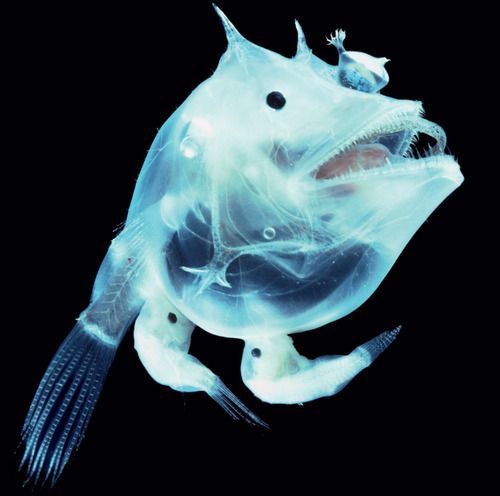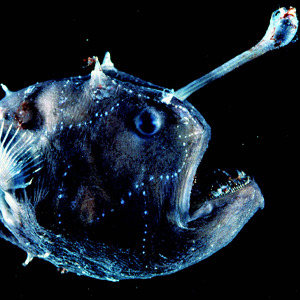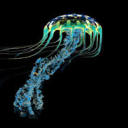Wolftrap Angler


Wolftrap Angler
Thaumatichthys binghami
The Wolftrap Angler is slightly different from many other species of anglers. It has its bioluminescent lure located inside of its mouth instead of connected to its body. Even though it is intimidating up close, it is only nine centimeters in size. It is found in the deep ocean at 2432m.
Photo credit
https://en.wikipedia.org/wiki/Thaumatichthys_binghami
https://igniteyourcuriosity.wordpress.com/2016/10/22/anglerfish/
More Posts from Bioluminescentoceangoddess and Others

Marrus orthocanna
Marrus orthocanna is a deep sea siphonophore found at depths between 400m to 2200m. It has a colony of gas-filled zooids on the top used for locomotion. It also has a long, bright orange tentacles on the bottom. Marrus orthocanna are viscous predators and consume small crustceans and copepods.
Photo credit: http://www.arcodiv.org/watercolumn/cnidarian/Marrus_orthocanna.html


Deep-sea white anglerfish
Haplophryne mollis
The Deep-sea white anglerfish is a ghostly white creature found at depths between 1000m to 4000m. The strange bulge between its eyes is a bioluminescent lure. The main fish above is a female and the tiny fish attached to her body are males. Since it is difficult to find mates in the deep ocean, male fish latch onto the female with hooked teeth. Even though the male fish are parasitic, they are eventually reduced to pockets of sperm that are used for reproduction. For all you fellas out there that have a rough time with the ladies, be thankful that you are at least not a bag of gonads floating through the ocean.
Photo credit: https://www.pinterest.co.uk/pin/440297301041956897/
https://news.cgtn.com/news/3d3d414d3559444f7a457a6333566d54/share_p.html



Black Dragonfish
Idiacanthus atlanticus
The Black Dragonfish are needle-like fish that migrate between 500m and 2000m in the deep ocean. Females are black with 6 stripes and lack a barbel, pelvic fins, and sharp teeth. Males, on the other hand, are dark brown and have a barbel, which is the light producing structure on its chin. Furthermore, it uses bioluminescence to detect prey instead of lure prey.
Photo credit: https://scitechdaily.com/scientists-learn-secrets-from-ultra-black-skin-that-allows-deep-sea-fish-to-lurk-unseen/
https://steemit.com/life/@munnashah/the-most-terrible-and-surprising-7-animals-of-the-sea
https://knowyourmeme.com/photos/995601-thalassophobia


Atolla Jelly
Atolla wyvillei
The Atolla Jelly is a fiery, red jellyfish that has an extraordinary display of bioluminescence. When the jelly is attacked, it uses bioluminescence to produce thousands of vibrant, blue flashes; the blue flashes act as an alarm, which draws in bigger predators and warns prey. The jelly can be found at depths between 600 m to 1500m, and it also has a long hypertrophied tentacle that aids in reproduction.
Photo credit: https://en.wikipedia.org/wiki/Atolla_jellyfish
https://en.wikipedia.org/wiki/Atolla_jellyfish
Sea sparkle is a common, bioluminescent plankton. Even though its not an animal, it is worth sharing.


Sea sparkle
Noctiluca scintillans
Sea sparkle is a bioluminescent dinoflagellate that blooms in many coastal waters. Sea sparkle feeds on plankton, diatoms, fish eggs, and other dinoflagellates. It also has a flagellum, or tiny tail, that helps it move around in the water. Even though sea sparkle is beautiful to witness at night, it is hazardous to other marine species and resembles a reddish-pink film during the day.
Photo credit:
https://alexandrathemb.tumblr.com/post/49814932878/noctilucas-scintillans-a-bioluminescent
https://thevelv.blogspot.com/2015/07/noctiluca-scintillans.html
Dear ocean enthusiast and supporters,
Hi everyone, thank you for supporting my blog. I have gained over 500 followers and that is worth celebrating. I will try my best to post every day some of the amazing creatures that live in the deep ocean. Have a great night!

Black Medusa
Vampyrocrossota childressi
The Black Medusa is an inky, black hydrozoan that absorbs all light that hits its tiny body. It has a translucent gelatin and a black umbrella; it is also only 1.5 cm in size. Moreover, it is found at depths between 600m to 1500m, and it spends its entire life floating in the deep ocean.
Photo credit: https://www.pinterest.com/pin/488148047080475827/

Vampire Squid
Vampyroteuthis infernalis
Even though the Vampire Squid is named after a notorious monster, this gentle creature does not live up to its name. It is only a foot long and occupies depths between 650m to 1500m in the deep ocean. Unlike other squids, it has reduced musculature and collects particles in the water column. However, it is capable of huge bursts of speeds. It uses bioluminescence to confuse both predators.
Photo credit: https://ocean.si.edu/ocean-life/invertebrates/vampire-squid-hell
Pyrocystis fusiformis is a common plankton that produces bioluminescence. Not exactly a marine animal, but an amazing organism that produces bioluminescence. So, I thought it was worth sharing on this page.



Pyrocystis fusiformis
Pyrocystis Fusiformis is a marine dinoflagellate that is non-motile and has a short life cycle (5-7 days). When disturbed, the dinoflagellate displays vibrant, blue bioluminescence. The bioluminescence is design to startle grazers, or cause them to glow, making them more vulnerable to predators. During the day, it uses photosynthesis to produce its own food, and it produce bioluminescence at night. Furthermore, it fixes carbon from the ocean and produces oxygen for the marine animals that live there. All in all, I find this diamond shaped plankton to be unique and beautiful.
Photo credit: https://fineartamerica.com/featured/2-bioluminescence-of-pyrocystis-fusiformis-gerd-guentherscience-photo-library.html
https://exploringtheinvisible.com/2013/11/21/c-mould-new-acquisition-pyrocystis-fusiformis/
https://www.flickr.com/photos/13084997@N03/32823053106


Football Fish
Himantolophus paucifilosus
The Football fish is a deep sea angular fish located between 1000 to 4000 meters in the ocean. The glowing dots on its body are sensory organs called neuromast that help the fish detect changes in the water.
Photo credit: https://alchetron.com/Footballfish
https://www.amazon.com/Creatures-Deep-Search-Monsters-World/dp/1770852816
-
 stopsixcrucifix reblogged this · 2 years ago
stopsixcrucifix reblogged this · 2 years ago -
 lauraatulsa reblogged this · 2 years ago
lauraatulsa reblogged this · 2 years ago -
 lauraatulsa liked this · 2 years ago
lauraatulsa liked this · 2 years ago -
 wildernestt reblogged this · 3 years ago
wildernestt reblogged this · 3 years ago -
 wildernestt liked this · 3 years ago
wildernestt liked this · 3 years ago -
 fated-to-madness liked this · 3 years ago
fated-to-madness liked this · 3 years ago -
 funkypeach77 liked this · 3 years ago
funkypeach77 liked this · 3 years ago -
 sleppybitch liked this · 3 years ago
sleppybitch liked this · 3 years ago -
 shylittlemoosen liked this · 3 years ago
shylittlemoosen liked this · 3 years ago -
 calamitycrash liked this · 3 years ago
calamitycrash liked this · 3 years ago -
 miresgaleth liked this · 3 years ago
miresgaleth liked this · 3 years ago -
 wieundalles liked this · 3 years ago
wieundalles liked this · 3 years ago -
 mr-crix liked this · 3 years ago
mr-crix liked this · 3 years ago -
 dr-w0rm liked this · 3 years ago
dr-w0rm liked this · 3 years ago -
 woahcoolbug reblogged this · 3 years ago
woahcoolbug reblogged this · 3 years ago -
 cherry-cola-beagle liked this · 3 years ago
cherry-cola-beagle liked this · 3 years ago -
 mintytrifecta liked this · 3 years ago
mintytrifecta liked this · 3 years ago -
 dragheadwashereat2019 liked this · 3 years ago
dragheadwashereat2019 liked this · 3 years ago -
 xeneric-shrooms liked this · 3 years ago
xeneric-shrooms liked this · 3 years ago -
 garlic-bready reblogged this · 3 years ago
garlic-bready reblogged this · 3 years ago -
 rugletthewren liked this · 3 years ago
rugletthewren liked this · 3 years ago -
 brines liked this · 3 years ago
brines liked this · 3 years ago -
 koipondplunderer liked this · 3 years ago
koipondplunderer liked this · 3 years ago -
 merdruid liked this · 3 years ago
merdruid liked this · 3 years ago -
 abluehappyface liked this · 4 years ago
abluehappyface liked this · 4 years ago -
 gratifymeimmediately liked this · 4 years ago
gratifymeimmediately liked this · 4 years ago -
 an-earwig liked this · 4 years ago
an-earwig liked this · 4 years ago -
 katbird0152 liked this · 4 years ago
katbird0152 liked this · 4 years ago -
 sharkyz liked this · 4 years ago
sharkyz liked this · 4 years ago -
 vtatters liked this · 4 years ago
vtatters liked this · 4 years ago -
 so-low-solo liked this · 4 years ago
so-low-solo liked this · 4 years ago -
 radioceann reblogged this · 4 years ago
radioceann reblogged this · 4 years ago -
 radioceann liked this · 4 years ago
radioceann liked this · 4 years ago -
 pixiestixss liked this · 4 years ago
pixiestixss liked this · 4 years ago -
 shinrachamploo liked this · 4 years ago
shinrachamploo liked this · 4 years ago -
 ramshackledtrickster liked this · 4 years ago
ramshackledtrickster liked this · 4 years ago -
 anonyhun liked this · 4 years ago
anonyhun liked this · 4 years ago -
 grim-witch liked this · 4 years ago
grim-witch liked this · 4 years ago -
 thespacebird liked this · 4 years ago
thespacebird liked this · 4 years ago -
 circusbabies-moved liked this · 4 years ago
circusbabies-moved liked this · 4 years ago -
 leopardsealz-remaking liked this · 4 years ago
leopardsealz-remaking liked this · 4 years ago -
 abyssalautistic reblogged this · 4 years ago
abyssalautistic reblogged this · 4 years ago -
 markroome liked this · 4 years ago
markroome liked this · 4 years ago -
 iris-collects liked this · 4 years ago
iris-collects liked this · 4 years ago -
 bludahoo liked this · 4 years ago
bludahoo liked this · 4 years ago -
 phobic-human liked this · 4 years ago
phobic-human liked this · 4 years ago

Bioluminescence is a chemical reaction that produces light. Many deep sea animals use bioluminescence. This blog is dedicated to educating the public about the amazing creatures that thrive in the deep sea.
57 posts